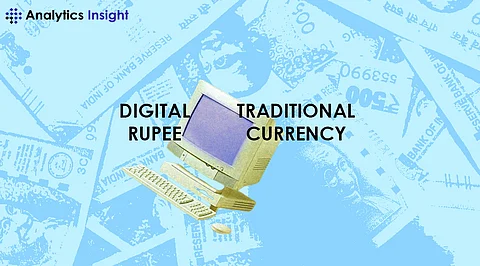

As digital payments become more prevalent worldwide, the concept of a Digital Rupee has gained significant attention. This article explores the fundamental differences between the Digital Rupee vs traditional currency, and examines the benefits each offers to individuals, businesses, and the broader economy.
The Digital Rupee is a form of Central Bank Digital Currency (CBDC) issued by the Reserve Bank of India (RBI). Unlike cryptocurrencies such as Bitcoin or Ethereum, the Digital Rupee is a legal tender regulated by the government. It is designed to complement physical cash and existing electronic payment systems, providing a modernized, efficient, and secure way to conduct transactions.
Checkout the key difference between Digital Rupee vs Traditional Currency
Digital Rupee: This exists purely in digital form and is stored in digital wallets. It is based on blockchain technology or other secure digital ledgers.
Traditional Currency: Exists in physical form as banknotes and coins, as well as in digital form within bank accounts.
Digital Rupee: Issued and regulated directly by the central bank (RBI). It is part of the country's monetary policy tools.
Traditional Currency: Also issued by the central bank, but physical cash circulates through commercial banks and financial institutions.
Digital Rupee: Transactions are processed electronically through digital wallets and blockchain networks. This reduces the need for intermediaries, ensuring faster settlement times.
Traditional Currency: Transactions involving cash require physical exchange, while electronic transactions are processed through banks and payment processors.
Digital Rupee: Transactions are recorded digitally, providing a transparent ledger. While it can offer anonymity similar to cash, privacy measures depend on the design and implementation by the central bank.
Traditional Currency: Cash transactions offer complete anonymity, whereas electronic transfers through banks are recorded and traceable.
Digital Rupee: Utilizes advanced cryptographic techniques to ensure security, making it resistant to counterfeiting and fraud.
Traditional Currency: Physical cash is vulnerable to theft, loss, and counterfeiting, though bank transactions are generally secure.
While aware of the differences between Digital Rupee vs Traditional Currency, users need to be aware of their benefits.
The Digital Rupee can help extend banking services to unbanked populations, particularly in remote and rural areas where access to physical banks is limited. Digital wallets can be accessed via mobile phones, making financial services more inclusive.
Digital transactions reduce the need for printing, handling, and transporting physical cash, leading to cost savings for the government and businesses. Transactions are processed instantly, improving overall economic efficiency.
The use of blockchain or other digital ledgers ensures transparency in financial transactions, making it harder to engage in illicit activities such as money laundering and tax evasion. This can help reduce corruption and increase trust in the financial system.
With real-time data on money flow and usage, the central bank can implement and monitor monetary policies more effectively. This can lead to better management of inflation, interest rates, and overall economic stability.
Digital currencies are less prone to physical theft and loss. Advanced encryption and secure digital ledgers ensure that transactions are safe from counterfeiting and fraud, providing a secure alternative to physical cash.
Physical cash is widely accepted for transactions, even in regions with limited digital infrastructure. It is a reliable medium of exchange that does not require technology or internet access.
Cash transactions provide complete anonymity, offering privacy for individuals who do not wish to have their financial activities tracked or recorded.
Physical cash provides a tangible sense of value, which can be psychologically reassuring for individuals who prefer to see and hold their money.
While taking about the challenges between Digital Rupee vs traditional currency, the Digital Rupee offers numerous benefits, its implementation also presents challenges. Ensuring cybersecurity, maintaining user privacy, and achieving widespread adoption are critical issues that need to be addressed. Additionally, there is a need for robust legal and regulatory frameworks to support the transition to a digital currency.
The Digital Rupee has emerged as a far more advanced solution to the traditional method of transacting, with qualities of speed, security, and ideality. However, it should be noted that over the years traditional means of currency has been very much in use because it is universally acceptable and users’ identities are not easily traceable. Managing a transitional approach between the current cash currency and adopting the isolation currency known as the Digital Rupee shall be important in formulating a great economic status in the future.
With the increasing use of technology in everyday life, the integration of Digital Rupee along with the traditional currency will help in creating the sense of the modern world along with the reliability of the traditional currency.
